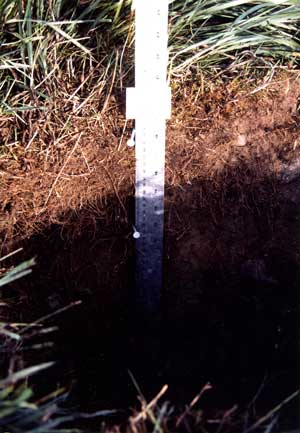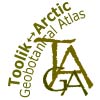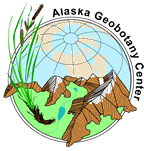Toolik Lake Permanent Vegetation Plots
Walker D.A. and Barry N. 1991. Toolik Lake permanent vegetation plots: site factors, soil physical and chemical properties, plant species cover, photographs, and soil descriptions. Data Report 48, Department of Energy R4D Program, Institute of Arctic and Alpine Research, University of Colorado, Boulder, CO.
Home //
Plot location map //
Preliminary vegetation classification //
Communities and microsites //
Environmental variables //
Environmental information: Abiotic data,
Biotic data //
Soils Characteristics //
Species Composition //
Selected Soil Descriptions //
Plot Photos
Soil Description, Plot SWT-48
|
 | | | Classification: | Pergelic Cryoboroll, fine-loamy, mixed. |
|---|
| Location: | Northwest side of Toolik Lake, directly above bay with creek from pond S-7 running into it. 68°38' N, 149°38' W. |
|---|
| Physiographic position: | Hillcrest |
|---|
| Topography: | Disturbed by animal activity (bird and squirrel mounds). |
|---|
| Microrelief Height: | 30 cm. |
|---|
| Drainage: | Well drained. |
|---|
| Vegetation: | Moist Poa glauca, Bromus pumpellianus s.l., Ranunculus pedatifidus, grass, forb tundra |
|---|
| Parent material: | Itkillik II glacial till. |
|---|
| Sampled by: | D.A. Walker and C. Westberg, August 9, 1989. |
|---|
| Remarks: | Many ground squirrel tunnels and dens. Shrub height: 50 cm. |
|---|
| Weather: | Cloudy, windy weather. |
|---|
| Horizons: | |
|---|
| Oi | 0-2 cm. Mat of moss (Thuidium abietinum) and dead grass litter. |
|---|
| Oa | 2-16 cm. Very dark brown (10YR 2.5/3) in dry condition or very dark brown (7.5YR 2/2.5) when wet sandy loam; weak medium subangular blocky, breaking to a very fine weak granular structure; dry; slightly gritty, slightly plastic, slightly sticky (wet); pH = 6.4; many fine and common fine roots; est. 10 percent fine gravel less than 2 cm diameter; gradual, wavy boundary. (Sample T-116). |
|---|
| B | 16-45+ cm. Yellowish brown (10YR 5/5, dry) or dark yellowish brown (10YR 3/4, wet) sandy loam; weak medium subangular blocky, breaking to a very fine weak granular structure; dry; gritty, slightly sticky, slightly plastic (wet); pH = 6.6; est. 20 percent of gravel and cobbles; carbonate stage 1 on underside of larger cobbles; areas of crotovinas have brown (10YR 4/3) dry color or dark brown (10YR 3/3) wet color; many very fine roots to 40 cm. (Sample T-117). |
|---|
| |
|---|
| |
|---|
|
|
| Enlarge soil photo |
|




